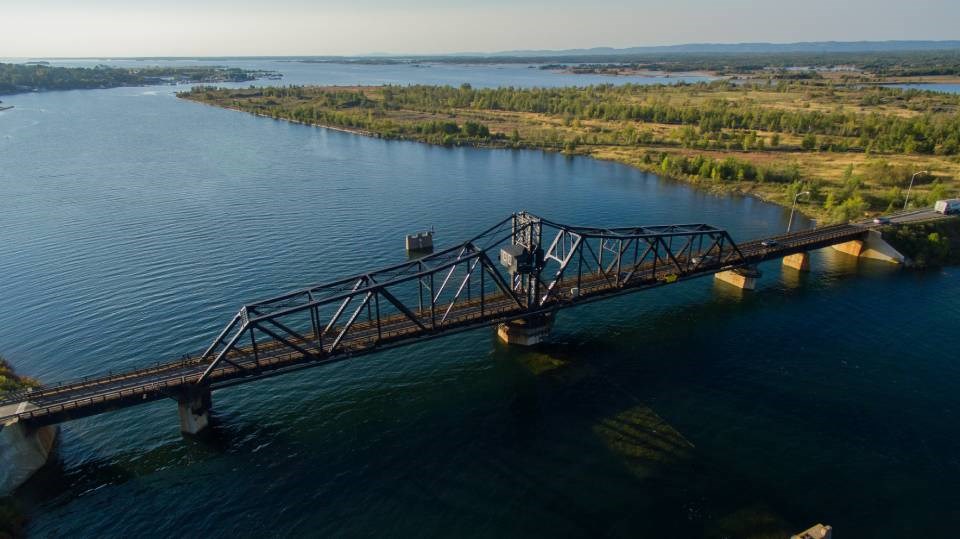Manitoulin Islanders eager to learn when they might see their 108-year-old swing bridge replaced are going to have to wait a little longer for an answer.
"We don’t know yet,” said Gregg Cooke, Stantec’s regional business leader for transportation, and the consulting project manager, during a March 31 presentation to the council of the Town of Northeastern Manitoulin and the Islands (NEMI).
“The first step is to get the environmental assessment study complete and have environmental clearance, and then the ministry will prioritize the project and determine the timing.”
Over the last three years, Cooke has led the rollout of a planning, preliminary design and environmental assessment (EA) study, commissioned in 2018 by the Ontario Ministry of Transportation, to figure out what to do with the aging swing bridge.
The results of that study were released to the public online on March 30 and are now available for review and comment.
Spanning a narrow channel in the upper part of Lake Huron’s Georgian Bay, the structure is part of a vital transportation corridor that connects Manitoulin Island at Little Current to the mainland of Northern Ontario.
During the winter months, the 112-metre-long, single-lane bridge remains in the closed position. But during the summer months, which are heavy with tourist activity, the bridge opens for about 15 minutes on the hour, every hour, to swing open and allow marine traffic to pass through.
In the last two decades, the ministry has spent millions on maintenance, including upgrading the bridge’s mechanical and electrical systems, refurbishing its concrete pier, and replacing the deck and riding surface.
In 2017, travellers faced delays when the ministry took two weeks to fix a broken wedge assembly – part of the mechanism that supports the bridge when it’s closed – and operators were forced to manually jack up the wedge upon each closing.
That same year, the ministry determined it was nearing the end of its service life and would eventually need to be replaced.
Until that time comes, however, Cooke said maintenance will continue as scheduled in order to keep the existing bridge running smoothly.
“Even though it’s nearing the end of its service life, the ministry is still committed to maintaining the existing bridge and keeping it operational and functional as long as possible,” Cooke said.
Want to read more stories about business in the North? Subscribe to our newsletter.
According to the proposal, Stantec is recommending the ministry replace the existing bridge with a through truss swing bridge – the same type that’s currently in place.
With a new bridge, traffic operations and user access will improve, operating and maintenance costs will decrease, and the crossing generally will be more reliable, Cooke said.
The new, two-lane bridge will be built along a more westerly alignment than its current route, he noted.
It will include a sidewalk on the west side, 1.5-metre shoulders that can accommodate users such as cyclists, along with vehicle-queueing lanes and traffic signals similar to what’s there now.
“The difference from (the existing bridge) is that once the bridge closes, then traffic will be open to the two lanes of traffic,” Cooke said. “So there won’t be additional delay waiting for a single lane of traffic to clear the bridge.”
This plan is favoured over others that Stantec considered because of its lower impact to traffic flow, residents and business owners, and the environment.
But considerations for the bridge are more than just practical.
Since its completion in 1913, the structure has been a treasured Manitoulin and North Shore landmark whose status as one of the few swing bridges in Canada earned it a place on the Ontario Heritage Bridge list.
Its cultural importance to the area is why it was so crucial to get public feedback, said Cooke, who assured council the view won’t be dramatically altered by the new configuration.
“We heard that it’s important to preserve and maintain the viewscapes in Little Current, both existing viewscapes from the town and from the channel,” he said.
“We heard that the existing bridge is a symbol of Manitoulin Island and it is a bit of a tourist attraction, and it has some historical value to the people.”
Because the bridge does carry a heritage designation, the Ministry of Heritage, Sport, Tourism and Culture Industries will have to give approval before it can be removed, Cooke noted.
He suggested the design of the new crossing would be “sympathetic” to the existing bridge, and that salvaged materials could even be used in tribute to the old structure.
During the design phase, the contractor might even explore the possibility of repurposing the old bridge, as a whole or in part.
“If there is a suitable location and if there is a suitable, willing party to take that existing bridge and do something with it, that will require a lot more work, a lot more discussion during detail design to see if there’s potential for that,” Cooke said.
Members of the public have until April 30 to review and provide feedback on the proposal.
Next, Stantec will complete and post the Transportation Environmental Study Report, which Cooke anticipated would be ready this summer.




